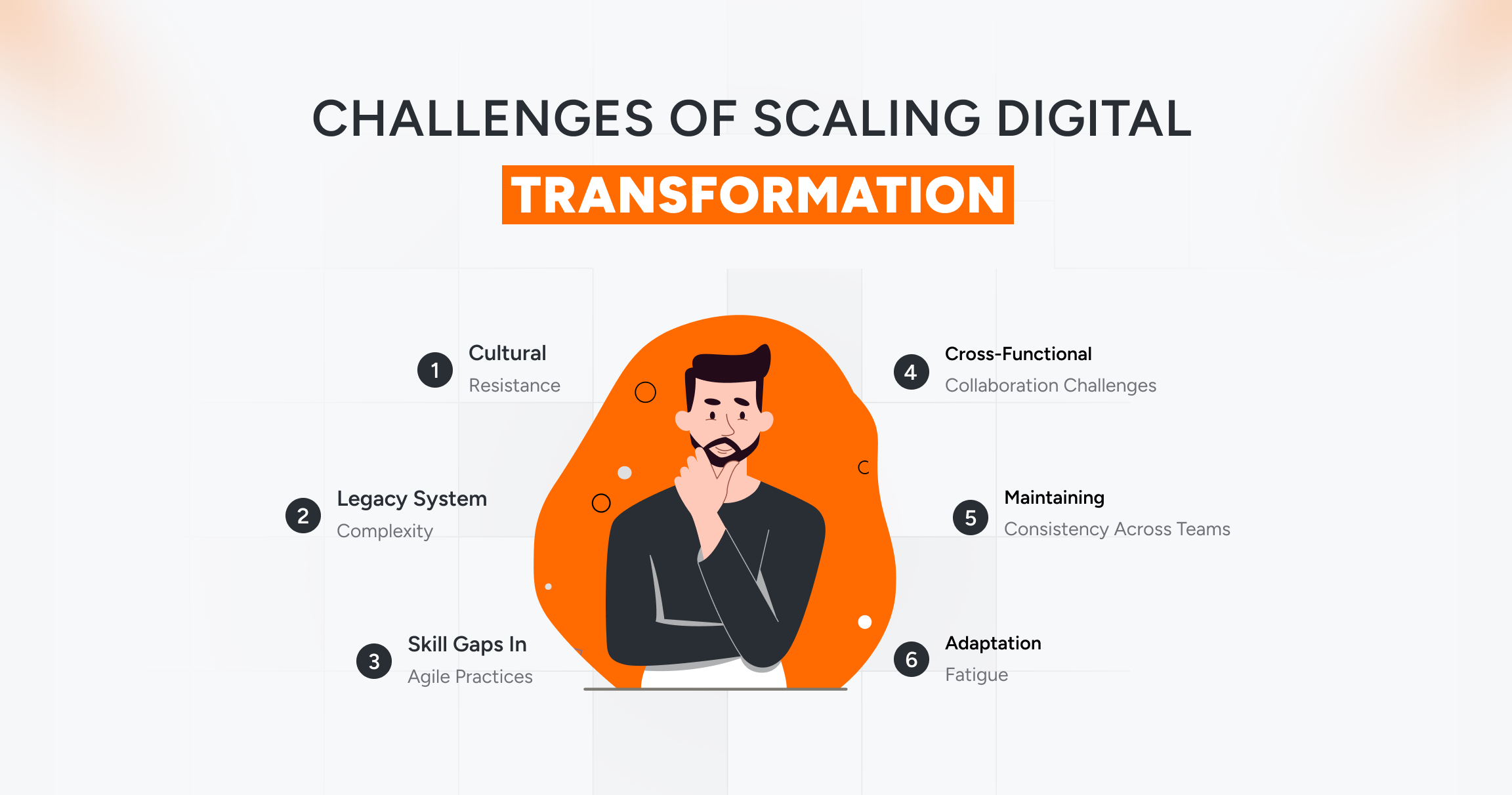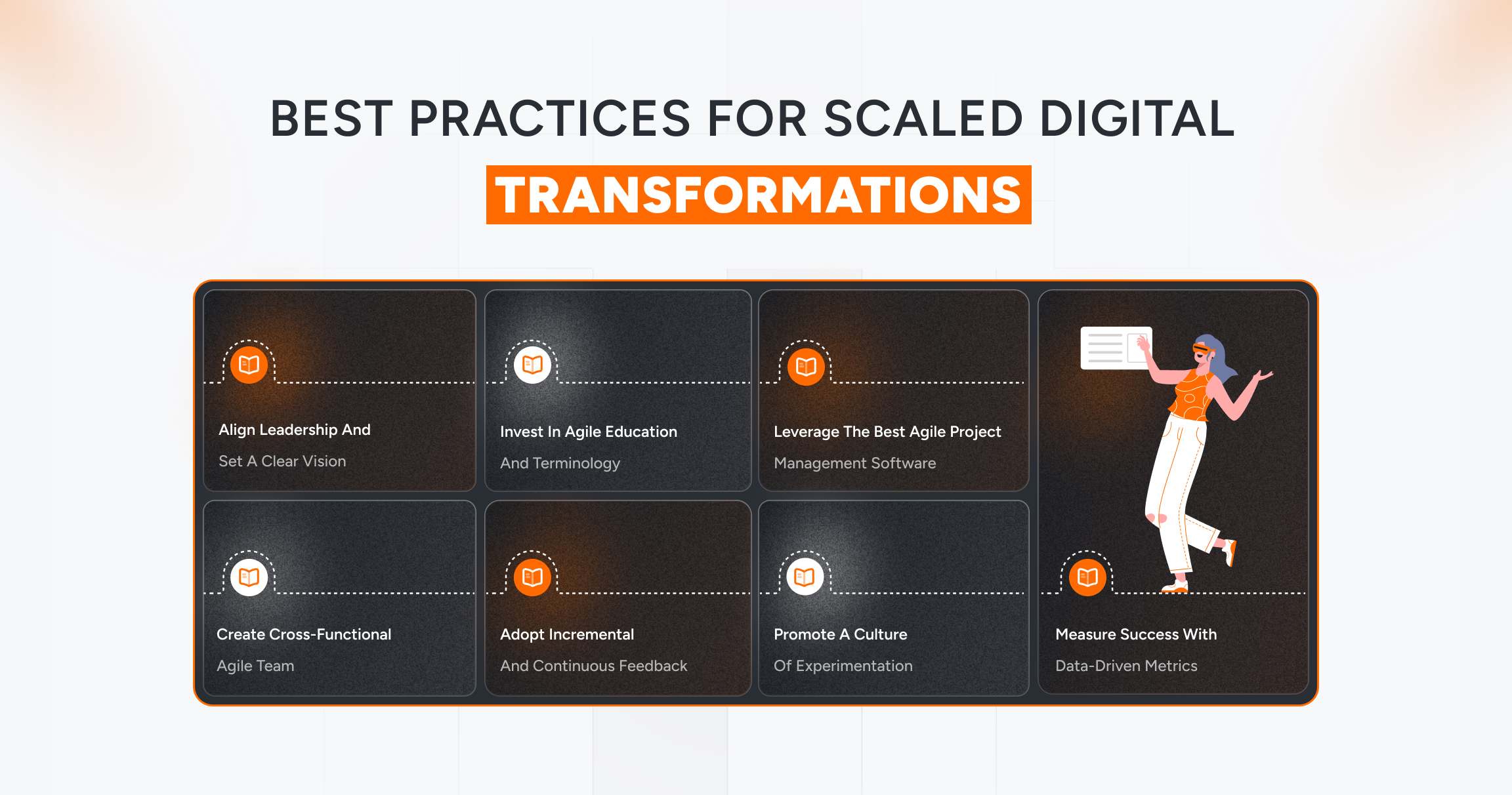The most significant pitfall of the modern business process is the inability to scale. Especially when you consider enterprise-grade systems and digital transformation initiatives, scaling becomes complex.
But why is this so?
A simple explanation can be the complexity of deployments at scale. When teams need to deploy systems at scale, they must ensure compatibility with various environments, configurations, and security requirements. All of this requires testing the system, analyzing results, and configuring environments, along with extensive observability.
Agile solutions can address this problem by ensuring extensive testing, integrating feedback, and scaling deployment. In fact, 71% of organizations are already using agile solutions for their software development lifecycle. However, using agile is not a silver bullet for all your scalability issues. You need a strategic agile solution for digital transformation business process management.
This is your enterprise guide to digital transformation, scale with agile solutions. It covers everything from what agile is, how it helps in digital transformation, to the industrial use cases, benefits, and challenges of adopting it.
Let’s first understand that it is an agile solution.
What is an Agile Solution?
An agile solution is a deliverable that utilizes an agile methodology to provide an iterative, incremental, and flexible approach for managing projects. Agile solutions enable you to optimize enterprise digital transformation projects. It focuses on quick adaptation to change and delivers value in small, frequent increments, leveraging a continuous improvement approach.
So, it’s clear that agile solutions can help you ensure scalable digital transformation. However, knowing what digital transformation includes becomes crucial before designing an agile solution.
What is Digital Transformation?
Digital transformation is a process of integrating various digital technologies across all areas of a business, changing how operations are carried out and value is delivered. Such a process goes beyond simply adopting a technology by creating a cultural shift within the organization.
Digital transformation enables the improvement of customer experience, streamlines business processes, and fosters innovation across products and services.
Why is Digital Transformation Important?
Digital transformation ensures,
- Personalized interactions, quick responses, and seamless online experiences.
- Task automation and streamlined workflows.
- Reduced costs and improved productivity.
- Data-driven and strategic decision-making.
- Innovation and Growth.
- Exploration of new business models.
- Development of new products and services.
- Fosters a collaborative environment and encourages experimentation.
Apart from the above perks that you get from digital transformation, it also helps you modernize your systems. With application modernization, you can digitally transform operations, ensuring better efficiency and ROI. In fact, Companies that align digital transformation with their strategy and technology investments have a 14% higher market value than those that do not.
It’s clear by now that digital transformation is key to achieving your organizational goals, but how do agile solutions ensure you reach them?
How do Agile Solutions help Scale Digital Transformations?
Agile solutions help enterprises scale their digital transformations, enabling higher flexibility, faster delivery, and continuous improvement. So if you are looking to use agile solutions for your enterprise digital transformation project, here is how it helps,
- Breaks the transformation into iterative steps or sprints that allow gradual rollouts
- It ensures real-time optimization of the iterations based on user feedback
- Fosters cross-functional collaborations, aligning teams on shared goals
- Helps embed agile frameworks beyond software development into enterprise functions
- Enables the usage of real-time data and automation to make data-driven decisions
- Allows teams to experiment and innovate, continuously reducing risks.
Agile solutions offer continuous improvement for digital transformation initiatives; however, they are accompanied by complexities and challenges during their implementation.
Key Challenges in Scaling Digital Transformation with Agile Solutions
Scaling enterprise digital transformation with agile solutions offers immense potential, but several challenges can hinder progress. Understanding these challenges and addressing them strategically can accelerate your journey toward successful digital transformation and scaling agile solutions.
1. Cultural Resistance
Changing established workflows and mindsets is difficult in large organizations. Employees often resist agile frameworks due to fear of disruption or uncertainty. This cultural inertia can stall digital transformation business process management efforts and delay execution.
🚀 Pro Tip: Drive change through clear communication, executive sponsorship, and immersive training programs. Share transformation examples that highlight successful agile adoption and brand elevation, and scale agile solutions to build enthusiasm.
2. Legacy System Complexity
Existing legacy systems are rigid and difficult to integrate with agile CRM software and modern agile tools. Integrating these systems without disrupting operations requires careful planning and coordination.
🚀 Pro Tip: Implement a phased legacy system migration strategy that combines modernization and coexistence. Hybrid cloud infrastructures often facilitate this approach, making digital transformation easier and enabling the scaling of agile solutions.
3. Skill Gaps in Agile Practices
A lack of understanding of agile software development terminology and best practices hinders the widespread adoption of agile practices across enterprise teams. Teams require expertise in various types of agile custom software development, including Scrum, Kanban, and SAFe.
🚀 Pro Tip: Implement continuous learning with professional certifications, agile coaching, and practical workshops. Align your teams around the best agile project management software to close skill gaps.
4. Cross-Functional Collaboration Challenges
Scaling agile beyond IT requires seamless alignment among diverse departments, which is often lacking in fragmented enterprises. Misalignment affects delivery speed and effectiveness.
🚀 Pro Tip: Encourage the use of agile CRM software and collaborative platforms that unify teams and data. Set aligned KPIs and foster cross-team rituals to support brand elevation and scale agile solutions.
5. Maintaining Consistency Across Teams
Distributed or global teams often adopt agile differently, leading to inconsistent outcomes and fragmented enterprise digital transformation initiatives.
🚀 Pro Tip: Standardize agile practices using shared agile software development terms and continuous feedback. Executive leadership should actively promote consistent agile adoption.
6. Adaptation Fatigue
Frequent iterations and continuous change, key to agile success, may result in stakeholder fatigue and reduced focus. Balancing the pace is critical.
🚀 Pro Tip: Prioritize initiatives with measurable impact and celebrate incremental wins. Use transformation examples to demonstrate value and sustain momentum.
Having understood the hurdles in scaling digital transformation with agile solutions, it’s vital to explore best practices that can guide enterprises toward successful and sustainable agile adoption.
Best Practices for Scaling Agile in Enterprise Digital Transformation
Scaling agile solutions in an enterprise setting requires a thoughtful blend of strategy, culture, and tools. To successfully scale your digital transformation and achieve brand elevation, enterprises must adopt proven best practices that extend agile principles beyond IT into all business functions.
1. Align Leadership and Set a Clear Vision
Enterprise digital transformation is most effective when leaders champion agile initiatives, set measurable objectives, and align goals with the overall business strategy. Clear vision drives commitment and guides digital transformation in business process management.
2. Invest in Agile Education and Terminology
Ensure that all teams understand agile software development terminology, including terms and frameworks such as Scrum, Kanban, or SAFe. This common language fosters collaboration and efficiency.
3. Leverage the Best Agile Project Management Software
Adopt tools optimized for coordination and visibility. Agile CRM software and project management platforms that support real-time data and automation enable cross-functional workflows and transparent progress tracking.
4. Create Cross-Functional Agile Teams
Organize teams with diverse skills from different departments to foster innovation, faster problem-solving, and shared accountability.
5. Adopt Incremental Delivery and Continuous Feedback
Break transformation into manageable sprints, encouraging real-time feedback loops to adapt and improve rapidly.
6. Promote a Culture of Experimentation
Encourage teams to test new ideas and processes safely, learning continually to optimize transformation outcomes. Share transformation examples internally to motivate and inspire.
7. Measure Success with Data-Driven Metrics
Use quantitative KPIs to evaluate progress, identify bottlenecks, and demonstrate value to stakeholders. Balancing these best practices enables enterprises to scale agile effectively within digital transformation initiatives, driving faster delivery, operational excellence, and sustained competitive advantage.
Industrial Use Cases of Agile-Driven Digital Transformation
Every industry has specific needs, and designing the agile solution to scale digital transformation requires an understanding of those requirements. Here is how you can leverage agile solutions for enterprise digital transformation.
Smart Manufacturing
With the advancements of artificial intelligence and the Internet of Things in the manufacturing sector has seen a transformation in operational output like never before. Manufacturing enterprises can leverage agile solutions to automate repetitive tasks, shorten production cycles, and enable rapid adjustments.
Supply Chain Optimization
Agile solutions allow enterprises to transform their supply chain operations, ensuring seamless digital transformation. Using an agile-based approach, enterprises can continuously integrate data from different sources in real-time. This helps improve the supply chain visibility and provides optimal operational capabilities.
Healthcare Sector
The healthcare industry frequently faces the challenge of meeting rising patient demands, delivering optimal care, and ensuring compliance with regulations. From patient record data management to pharmaceutical order systems, agile-driven digital transformation can address several challenges. It can help healthcare organizations reduce manual work, increase productivity, and streamline the diagnostic process.
Retail and ECommerce
Agile solutions enable retailers to rapidly adapt to changing customer behavior, personalize shopping experiences, and optimize omnichannel strategies. By leveraging agile frameworks, eCommerce platforms can implement real-time price adjustments, expedite product launches, and ensure seamless inventory synchronization across all channels.
Automotive and Mobility
Agile-driven digital transformation enables automotive enterprises to scale connected vehicle ecosystems and autonomous mobility solutions. Leveraging agile methodologies, automakers can shorten R&D cycles, deploy over-the-air (OTA) updates, and adapt quickly to evolving safety and compliance regulations.
How AQe Digital Helps You With Agile Solutions For Scaling Digital Transformation?
The iterative approach that agile solutions provide ensures continuous improvements, integrations, and scaling of digital transformation. Whether your enterprise is in the healthcare domain, supply chain, or manufacturing, agile-based digital transformation scaling can be beneficial. And not just in terms of cost reduction, it can also help you streamline delivery and optimize outcomes.
However, it’s the execution part that makes agile adoption challenging. You need strategic processes and a gradual approach to ensure there are no change management issues. This is where AQe Digital can help. With over a decade of experience in enabling enterprise transformation, our team has helped organizations across various industries successfully adopt agile frameworks.
From evaluating operational bottlenecks to implementing iterative sprints and aligning business goals with technology outcomes, we ensure a tailored approach for every enterprise. By combining our expertise in enterprise software, automation, and agile methodologies, AQe Digital empowers businesses to:
- Accelerate time-to-value with scalable agile frameworks.
- Improve cross-functional collaboration and productivity.
- Ensure compliance while modernizing legacy systems
- Enhance customer experiences with continuous product innovation
Partner with AQe Digital now for agile-driven digital transformation that scales as per your enterprise goals.
FAQs
The biggest challenge is overcoming resistance to change and aligning the existing company culture with new agile practices. Leadership commitment and clear communication are essential for success.
Agile is not just a methodology but a broad mindset focused on collaboration, continuous improvement, and iterative development, adaptable across teams and entire enterprises.
Agile transformation timelines vary, but most enterprises start seeing meaningful organizational change within 12–24 months, depending on leadership support and readjustment cycles.
Executive sponsorship is crucial; without active engagement from leadership, agile initiatives risk stalling or devolving into isolated team efforts rather than driving enterprise-level change.
Common ROI measures include reduced time-to-market, cost savings, more adaptive innovation cycles, and improved stakeholder satisfaction, but results depend on process alignment and ongoing feedback.
Framework choice should be based on an organization's size, goals, and readiness for change; sometimes, hybrid or scaled models are necessary for large, complex organizations to realize the benefits of agility.





